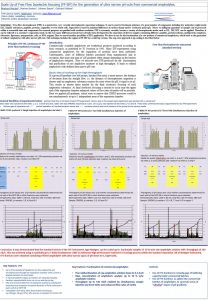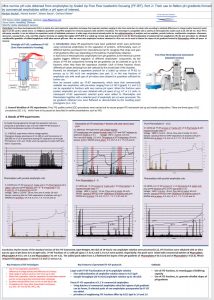Manifold FF-IEF-process
Scale Up of Free Flow Isoelectric focusing (FF-IEF) for the generation of ultra narrow pH-cuts from commercial ampholytes.
Abstract:
Free-flow electrophoresis (FFE) is a matrix-free, very versatile electrophoretic separation technique. It can be used to fractionate mixtures of a great number of components including low molecular weight metal ions, organic substances, peptides, proteins, organelles or even whole cells. Separation is based on minimal differences in surface charge and/or isoelectric point (pI). Micro- to milligram quantities of samples can be processed within a reasonable time and components for research purposes are purified with excellent resolution. FFE is extremely versatile, because a variety of electrophoretic modes such as ZE, IEF, IZE can be applied. Therefore, it can be tailored to a customer’s separation needs. In this way many different protocols have already been developed for the separation of diverse samples containing different peptides, protein isoforms, multiprotein complexes, ribosomes, liposomes, nanoparticles, cells, or DNA origami. Here we unveil another possibility of FFE application. We show its use for the fractionation of a raw product of commercial ampholytes, which leads to the generation of refined ampholytes with ultra narrow pH-cuts. This technique includes the regime of FF-IEF in a scaled up version. The step-wise approach to up-scaling is described below.
Ultra narrow pH-cuts obtained from ampholytes by Scaled Up Free Flow Isoelectric focusing (FF-IEF). Part 2: Their use to flatten pH gradients formed by commercial ampholytes within a pH span of interest.
Scale Up of Free Flow Isoelectric focusing (FF-IEF) for the generation of ultra narrow pH-cuts from commercial ampholytes.
Abstract:
Free-flow electrophoresis (FFE) is a matrix-free electrophoretic separation technique that separates analytes ranging in size from metal ions to whole cells according to minimal differences in charge and/or isoelectric point (pI). It can be used to obtain micro- to milligram quantities of purified samples for research purposes with excellent resolution. The technique is compatible with a variety of electrophoretic modes such as ZE, IEF, IZE etc. Since FFE is extremely versatile, it can be tailored to separation needs of individual customers. A wide range of protocols already exists for the subfractionation of analytes such as peptides, protein isoforms, multiprotein complexes, ribosomes, liposomes, nanoparticles, cells, and DNA origami. Recently we applied the regime of FF-IEF in a scaled up version and demonstrated its use for the fractionation of commercial raw ampholytes. By the new procedure we obtained considerable quantities of refined ampholytes with ultra narrow pH-cuts. Here we show that ampholyte fractions obtained in a first run can be used to flatten the slopes of pH gradients formed by Pharmalytes within pH spans of interest.

